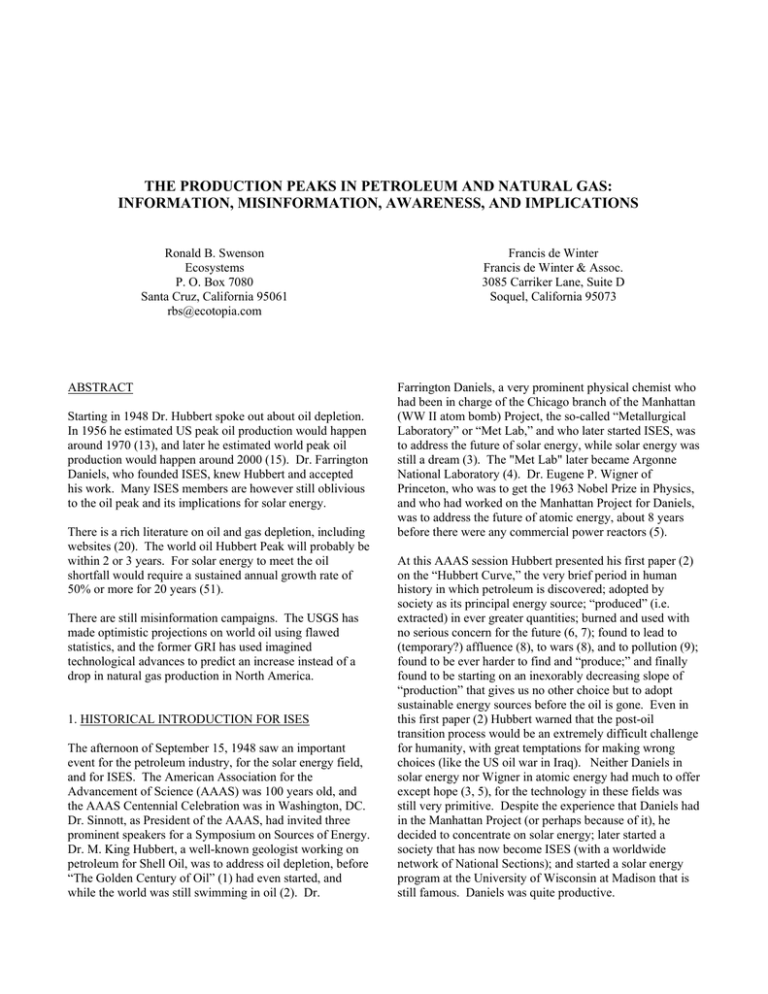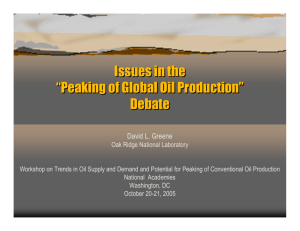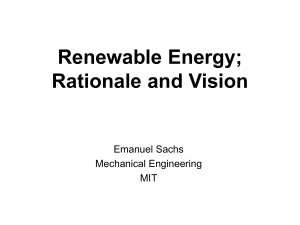the production peaks in petroleum and natural gas
advertisement

THE PRODUCTION PEAKS IN PETROLEUM AND NATURAL GAS: INFORMATION, MISINFORMATION, AWARENESS, AND IMPLICATIONS Ronald B. Swenson Ecosystems P. O. Box 7080 Santa Cruz, California 95061 rbs@ecotopia.com ABSTRACT Starting in 1948 Dr. Hubbert spoke out about oil depletion. In 1956 he estimated US peak oil production would happen around 1970 (13), and later he estimated world peak oil production would happen around 2000 (15). Dr. Farrington Daniels, who founded ISES, knew Hubbert and accepted his work. Many ISES members are however still oblivious to the oil peak and its implications for solar energy. There is a rich literature on oil and gas depletion, including websites (20). The world oil Hubbert Peak will probably be within 2 or 3 years. For solar energy to meet the oil shortfall would require a sustained annual growth rate of 50% or more for 20 years (51). There are still misinformation campaigns. The USGS has made optimistic projections on world oil using flawed statistics, and the former GRI has used imagined technological advances to predict an increase instead of a drop in natural gas production in North America. 1. HISTORICAL INTRODUCTION FOR ISES The afternoon of September 15, 1948 saw an important event for the petroleum industry, for the solar energy field, and for ISES. The American Association for the Advancement of Science (AAAS) was 100 years old, and the AAAS Centennial Celebration was in Washington, DC. Dr. Sinnott, as President of the AAAS, had invited three prominent speakers for a Symposium on Sources of Energy. Dr. M. King Hubbert, a well-known geologist working on petroleum for Shell Oil, was to address oil depletion, before “The Golden Century of Oil” (1) had even started, and while the world was still swimming in oil (2). Dr. Francis de Winter Francis de Winter & Assoc. 3085 Carriker Lane, Suite D Soquel, California 95073 Farrington Daniels, a very prominent physical chemist who had been in charge of the Chicago branch of the Manhattan (WW II atom bomb) Project, the so-called “Metallurgical Laboratory” or “Met Lab,” and who later started ISES, was to address the future of solar energy, while solar energy was still a dream (3). The "Met Lab" later became Argonne National Laboratory (4). Dr. Eugene P. Wigner of Princeton, who was to get the 1963 Nobel Prize in Physics, and who had worked on the Manhattan Project for Daniels, was to address the future of atomic energy, about 8 years before there were any commercial power reactors (5). At this AAAS session Hubbert presented his first paper (2) on the “Hubbert Curve,” the very brief period in human history in which petroleum is discovered; adopted by society as its principal energy source; “produced” (i.e. extracted) in ever greater quantities; burned and used with no serious concern for the future (6, 7); found to lead to (temporary?) affluence (8), to wars (8), and to pollution (9); found to be ever harder to find and “produce;” and finally found to be starting on an inexorably decreasing slope of “production” that gives us no other choice but to adopt sustainable energy sources before the oil is gone. Even in this first paper (2) Hubbert warned that the post-oil transition process would be an extremely difficult challenge for humanity, with great temptations for making wrong choices (like the US oil war in Iraq). Neither Daniels in solar energy nor Wigner in atomic energy had much to offer except hope (3, 5), for the technology in these fields was still very primitive. Despite the experience that Daniels had in the Manhattan Project (or perhaps because of it), he decided to concentrate on solar energy; later started a society that has now become ISES (with a worldwide network of National Sections); and started a solar energy program at the University of Wisconsin at Madison that is still famous. Daniels was quite productive. After this Symposium Daniels, Hubbert, and Wigner coauthored a paper (10), which may well have led to the later Paley Report (11). Getting to know Hubbert made Daniels aware of the schedule of oil depletion that we could expect, and of the transition problems and energy needs that solar energy would have to address. In 1964 he wrote (12) that US oil “production” would peak in about 5 years, as Hubbert had predicted accurately in 1956 (13), and that worldwide oil scarcity could be expected shortly after 2010. By the 1970s Hubbert expected the world peak to be shortly before 2000 (14, 15). The “Energy Crisis” of the 1970s made us more frugal with oil, as shown in Figure 1, and this delayed the world oil Hubbert Peak, which is now likely to be within the next 2 or 3 years (16-21). Given the understanding of Daniels, who started ISES, one would expect the current ISES members to be fully aware of the facts of oil depletion. Yet that is not so. Many inside and outside of ISES seem to think that there is plenty of oil for decades ahead, despite many references to the contrary (1, 2, 13-38), including even ISES publications (25). Global warming (40-42) is often taken to be the major threat by those unaware of oil scarcity (43, 44). The “misinformation campaign” in oil and gas (see below) has been quite effective. conventional oil, and that it does not shift the peak much. Simmons (18) recently concluded that the oil fields of Saudi Arabia have been seriously damaged by excessively rapid production, and that this will reduce future production, making the decline steeper than that of Figure 1. To avoid deprivation, the gap between energy demand and production must be met by energy efficiency, other energy sources including solar, a lower population, and changes in lifestyle (51). The future will be difficult, but the outcome will depend on the response of humanity, and ISES must help to make that a better-informed response. 2. INFORMATION ON OIL AND NATURAL GAS SUPPLIES 3. THE OIL AND GAS MISINFORMATION CAMPAIGN The authors have been following this topic for decades (6, 20, 45). In 1994 they met Campbell and Laherrère , and arranged to get articles by Campbell into SunWorld (25). Our hubbertpeak.com website (20) is the first (and still the primary) website on this topic, and has a large number of articles and contributions from many of the most widely respected petroleum geologists in the world. Today many of the best young minds end up in Silicon Valley, but for decades before Silicon Valley existed many of the best young minds ended up in petroleum geology. Geologists understand when and how and where oil was created and stored securely (46), they are very skilled at finding oil fields and at estimating how much oil can be recovered from a field, and they are the only ones who can be trusted to determine how much recoverable oil is left, in known fields as well as in the fields likely to be found in the future. Economists (and others) disputing the results of the best petroleum geologists are like small children challenging Einstein in physics. For decades oil and gas have been critical commodities in the world economy. Since the reserves are hidden underground, it is easy to report false numbers. Reporting false reserves has been so widespread that studies have been made about it (50), and a popular saying in Texas is: “There is no such a thing as an honest oilman.” There are many reasons for reporting false reserves: one wants to look poor to the taxman, healthy to the bankers and shareholders, secretive to the competition, and socially responsible to the media (35). The SEC forbids US companies to claim more in reserves than can be produced (i.e. extracted) in a limited time using existing equipment. Generally companies have reported no more in reserves than necessary, updating the numbers on reported reserves regularly. Many think the revised numbers reflect new discoveries, but that is not really true (35). Recently Shell Oil was forced to admit that its reported reserves were wrong, but candor is rare. In the 1980s members of OPEC made huge increases in their reported reserves, since this led to higher production quotas (20). A real difficulty is that the terminology on reserves is not defined precisely: “There seems to be a consensus for not having any consensus on definitions” (35). There are now many sources of information on the world oil and natural gas supplies (1, 2, 13-39, 46-50). Figure 1 is the most current graph on the expected production of liquid petroleum products of Campbell (17). It shows that the peak production is in 2006 or 2007, that non-conventional oil cannot fully compensate for the depletion of For decades natural gas was only a worthless byproduct of oil production, “flared” (i.e. burned) at the site. Selling natural gas cheaply finally gave it a large market. Natural gas can be transported by pipelines on land, but it must be carried overseas, at great cost and at a risk of great danger, as a very cold liquid in “LNG” tankers (52). The North American continent is already beyond its natural gas production peak (23), and will never see cheap natural gas again. At present, night photos (53) still show large-scale gas flaring in Brazil, Venezuela, West and North Africa, the Middle East, Indonesia, Siberia, the North Atlantic, and elsewhere. Some have tried to discredit Hubbert ever since his first paper came out (29). The (now dissolved) Gas Research Institute (GRI) published a report (47) in the year 2000 predicting that based on pre-1998 technology the natural gas supply of the USA would be reduced by 30% by the year 2015, but based on post-1998 technology the supply would be increased by 50%. An analogy in personal finance is a person who expects to be a billionaire by March based on ideas just being discovered. The USGS recently published the end results of a major “study” (48) in which it claimed that the amount of ultimately recoverable world oil is 50% more than any reputable geologist has accepted thus far, and that world oil problems are still decades away. Some believe this (39, 44), but Leslie B. Magoon disagrees completely with the recent USGS numbers. He has been one of the most respected petroleum geologists on the staff of the USGS (46), and he is an expert on the petroleum reserves on the north slope of Alaska, with many references to his petroleum exploration in Alaska (especially of ANWR) made in the articles of the book he edited (46). He has made lecture tours, even in Australia, to tell the world to trust the numbers of Campbell (17), and not those of the USGS (48); and his views of the oil future are posted on our website and on the USGS website (36). Campbell made critical comments on the USGS projections (31), Laherrère has a detailed refutation (37), and Deffeyes considers the recent USGS ANWR projections to be laughable (19). There have been earlier misinformation campaigns on petroleum reserves by the USGS (29). One of the Directors of the USGS, Vincent McKelvey, was fired during the Carter Administration precisely because he was fabricating and issuing numbers on petroleum reserves that were totally out of line with reality (50). McKelvey also provided support for the excessive estimates made at the USGS by Zapp (54), which Zapp had made by assuming that the number of barrels of oil found per foot of exploratory drilling would always be the same. Hubbert pointed out that the Zapp numbers were far too high, since the number of barrels of oil found per foot of exploratory drilling had been going down for decades, and would continue going down forever. That is because petroleum geologists drill only in the best locations, and the locations that are still unexplored become ever worse, as all the biggest and best options are explored. This consideration reduced the numbers of Zapp by a factor of 3, and made them reasonable (50). Hubbert used to say that some economists are able to find twice as much oil on paper as a geologist can find in the ground. Some economists claim that higher oil prices will produce much more oil. This requires the elasticity of the oil supply to be high, but the record (e.g. of the USA in the 1970s) shows the elasticity to be very low. Reynolds found that since the Hubbert Peak in the USA the elasticity in oil supply has been less than 5% or even less than 2.5% (32). Double the price, and the supply increases by less than 5% or even less than 2.5%, dashing the hopes of Adelman, Lynch, Yergin (8, 55-58), and of many other oil supply optimists. A recent article (embellished with full page advertisements of Exxon Mobil; Conoco Phillips; Halliburton; Emerson, a partner of Shell; and several other companies tied to the oil industry) disagreed with Hubbert, Campbell, Laherrere, and Simmons; agreed with all the oil supply optimists; and claimed that oil will be plentiful for long (58). Last year Exxon Mobil had over US$25 billion in profits (58), and spent over US$8 million on “science” and publicity casting doubts on the reality of global warming (42, 59). If global warming optimists have that much in financial support, there surely are rewards for being a highly outspoken oil supply optimist (60). There have been earlier and equally determined misinformation campaigns, on asbestos, on "black-lung" disease in the mining industry, on tobacco and nicotine, on DDT, on Dioxin, on the US wars in Vietnam and in Iraq, on car seatbelts, on catalytic converters for automobiles, on leaded gasoline, on global warming, and on many other topics (60). On virtually all of these (including oil supplies) the tactics of the misinformation sources have been the same: cast doubts on the predictions and on the seriousness of the opposition without any evidence to back up those doubts or those charges, and make alarming predictions on the economic (or political, or whatever) disasters that will occur if the opposition is allowed to prevail. US government agencies have often been active sources of the misinformation, in a flagrant dereliction of duty (63). The public has often been kept in the dark. Public awareness of energy scarcity can be very useful, but currently the world is almost oblivious to the impending problems. Figure 1 shows what people did when they felt a reduced oil demand was essential, after the “Energy Crisis” of the 1970s. WW II also saw this type of enthusiasm (62). When the World Oil Hubbert Peak is widely recognized, it is to be hoped that the whole world will accept the challenge, and that a large part of humanity will become involved in the transition effort. 4. AWARENESS AND IMPLICATIONS In 1949 Daniels et al examined the energy future (10). In 1952 a Commission headed by William Paley presented a report (11) to President Truman, advising him that the transition to sustainable energy should be started. In 1981 SERI, under Denis Hayes, prepared a report with similar advice (64). Last year Denis Hayes handed out a sheet (65) to go with his talk to the ASES conference, in which he concluded that this transition can no longer be painless. ISES and other groups have published reports (43, 44, 66) on this transition. We have a website in which this transition effort is called the “Apollo 2 Program” (51), and a US union group has now adopted this name (67). In 1972 the Club of Rome published a book on the effects of limited resources on growth (68), and recent publications (69, 70) seem to confirm its findings. Books have been written about the advantages of sustainable economies (71-73). Until now all of this has not had much impact, because there has not yet been a clear crisis for the political system to address. When people see the oil era is beginning to end, that may change (74), and big changes may happen rapidly (75). We will need to avoid the chaos that Hubbert (2) and Duncan (76) have warned about, and that will require learning from history (62, 63, 77-79). an R&D forum, and ISES will have to be responsive to these new members. If ISES is to survive and prosper, it can no longer have any Members on its Board of Directors who only use ISES as a travel agency to see the world. ISES must be turned into the principal NGO to guide humanity into the future, and only highly devoted, active, and competent Board Members can do that. That must be what Farrington Daniels intended, but if ISES does not meet the challenges it faces, it will be left behind. The current fossil fuel economy has been established and maintained by an intricate web of taxes, subsidies, and defense policies built by political pressures; and the whole structure of society has been custom-built around this fossil fuel economy (6). To call the current world a “free-market economy” in which new energy technologies must be able to survive on their own is quite comical (6). The economy must be pushed in the right direction by the “political leadership,” but this “political leadership” will do nothing until the public will becomes stronger than the entrenched energy establishment. This will only happen when the public becomes aware, and ISES and its National Sections must become reliable sources of information to make the public aware. We have included only one figure and a few numbers in this paper, but there is a wealth of information at the websites and references we cited. By following Dr. Farrington Daniels’ example of 56 years ago, ISES members can get a good understanding of the depletion of oil and natural gas, both locally and worldwide. There are few matters in solar energy that are more important than an awareness of the real and urgent need for it. The slowly decreasing oil and gas supplies in the next few decades will impose the same energy transition needs on all of humanity. The world is still in a state of denial, and no serious transition program has started anywhere. In Japan, India, and Europe there are serious efforts in support of renewable energy. In the USA very little is going on, except at the state level. President Bush is a member of the fourth generation of a family devoted to fossil fuels (80). The USA is now causing major environmental damage in Wyoming to produce coal bed methane (81, 82); in the hills of Appalachia to produce coal (83); and in the Alaska National Wildlife Refuge (ANWR) to produce an amount of oil that would not be of significance even if the USGS estimates on ANWR reserves (48) were not considered to be laughable (19). Brute force efforts like the US oil war in Iraq can only be counter-productive, especially when they are started for reasons known to be false, cloaked in hypocrisy and chauvinism, and carried out without any understanding and in total defiance of international law. Solar energy can increase energy independence, reduce the need for war, and provide many jobs (67). ISES must be central in the energy transition program, which is likely to involve huge numbers of people (62, 67). Until now ISES and its Sections have only had a few thousand members, but the memberships could become enormous. Many will seek personal understanding and involvement, rather than 5. CONCLUSIONS AND RECOMMENDATIONS 6. REFERENCES 1. C. J. Campbell: “The Golden Century of Oil - 1950 to 2050,” Kluwer Acad. Publ., Dordrecht, The Netherlands, 1991 2. M. King Hubbert: “Energy from Fossil Fuels,” Science (an AAAS Journal), Vol. 109, 1949, pp 103-109 3. F. Daniels: “Solar Energy,” Science, Vol. 109, 1949, pp 51-57 4. Anon: “The First Reactor – 40th Anniversary,” US DOE report DOE/NE-0046, Washington, DC, December 1982 5. E. P. Wigner: “Atomic Energy,” Science, Vol. 108, 1948, pp 517-521 6. F. de Winter: “Economic and Policy Aspects of Solar Energy,” Proc. Intersol 85 ISES Congress, Montreal, Canada, Pergamon, NY, 1986, Vol. 4, pp 2207-2218 7. H. Hotelling: “The Economics of Exhaustible Resources,” Jl. of Polit. Econ., Vol. 39, No. 2, April 1931, p 137 8. D. Yergin: “The Prize – The Epic Quest for Oil, Money, & Power,” Simon & Schuster, NY, 1991 9. J. R. McNeill: “Something New Under the Sun – An Environmental History of the Twentieth Century World,” Norton, NY, 2000 10. F. Daniels, M. K. Hubbert, and E. P. Wigner: “Our Energy Resources,” Physics Today, April 1949, pp 18-22 11. The President’s Materials Policy Commission (headed by William Paley): “Resources for Freedom,” Five Volume Report to Pres. Truman, June 1952 12. F. Daniels (1964): “Direct Use of the Sun’s Energy,” Ballantine Books, NY (see page 3 or page 4) 13. M. K. Hubbert: “Nuclear Energy and the Fossil Fuels,” Pub. No. 95, Shell Dev. Co. Expl. & Prod. Res. Div., Houston, TX, June 1956 14. N. Grove: “Oil, the Dwindling Resource,” Nat. Geogr., June 1974, pp 792-825 15. M. K. Hubbert: “The Energy Resources of the Earth,” Energy and Power, A Sci. American Book, Freeman & Co., San Francisco, 1971, pp. 31-40 16. R. C. Duncan: “Three World Oil Forecasts Predict Peak Oil Production,” OGJ, May 26, 2003 17. C. J. Campbell: “The Essence of Oil & Gas Depletion,” Multi-Sci. Publ. Co., Ltd., Essex, UK, 2003; see also www.oilcrisis.com/campbell/images/2004Scenario.jpg 18. M. Simmons: “Twilight in the Desert: The Coming Saudi Oil Shock and the World Economy,” J. Wiley, NY, 2005 19. K. S. Deffeyes: “What Happens Once the Oil Runs Out?” New York Times, March 25, 2005, page A19 20. See www.hubbertpeak.com; www.hubbertpeak.com/dewinter; www.dieoff.org; www.peakoil.net 21. R. C. Duncan and W. Youngquist: ”Encircling the Peak of Oil Production,” Natural Resources Research, Vol. 8, No. 3, 1999, pp 219-232 22. R. Williams: “Future Energy Supply - Oil Depletion,” Oil & Gas Journal (OGJ) Jul 14, 2003. See also Williams OGJ “Future Energy Supply” articles: “Natural Gas Potential,” (Jul 21, 2003); “Heavy Oil and Tar Sands,” (Jul 28, 2003); and “Potential from Improved Oil Recovery,” (Aug 4, 2003) 23. W. Youngquist and R. C. Duncan: “North American Natural Gas: Data Show Supply Problems,” Natural Resources Research, Dec. 2003, pp 229-240 24. R. Heinberg: “The Party's Over - Oil, War, and the Fate of Industrial Societies,” New Soc. Publ., Gabriola Island, BC, Canada, 2003 25. C. J. Campbell: “The Imminent End of Cheap OilBased Energy,” ISES SunWorld, V 18, N 4, Dec. 1994, pp 17-19. See also: “Taking Stock,” in V 19, N 1, March 1995, pp 16-19, and: “The Coming Crisis,” in V 19, N 2, June 1995, pp 16-19 26. C. J. Campbell: “The Coming Oil Crisis,” Multi-Sci. Publ. Co. Ltd., Essex, UK and Petroconsultants, 1997 27. C. J. Campbell and Jean Laherrère : “The End of Cheap Oil,” Sci. American, March 1998, pp 78-83 28. C. J. Campbell: “Running Out of Gas - This Time the Wolf is Coming,” The National Interest, Number 51, Spring 1998, pp 47-55 29. K. S. Deffeyes: “Hubbert's Peak - The Impending World Oil Shortage,” Princeton Univ. Press, 2001 30. B. Fleay: “The Decline of the Age of Oil - Petrol Politics: Australia's Road Ahead,” Pluto Press Austr., Annandale, 1995 31. C. J. Campbell replies to: “Global Petroleum Reserves – A View to the Future,” of T. S. Ahlbrand and J. McCabe of the USGS in Geotimes, Nov. 2002, at hubbertpeak.com/news/article.asp?id=3659 32. D. B. Reynolds: “Scarcity and Growth Considering Oil and Energy - An Alternative Neo-Classical View,” Edwin Mellen Press; Lewiston, NY, USA, 2002 33. D. Goodstein: “Out of Gas - The End of the Age of Oil,” Norton, NY, 2004 34. P. Roberts: “The End of Oil: On the Edge of a Perilous New Journey,” Houghton Mifflin, NY, 2004 35. J. Laherrère : “Previsions de Production de Combustibles Fosiles, et Consequences sur l’Economie et le Climat,” Feb. 5, 2005, www.hubbertpeak.com/Laherrère/metatm.pdf 36. The Magoon material is at: geopubs.wr.usgs.gov/openfile/of00-320/ and at www.hubbertpeak.com/magoon/ 37. Laherrère, www.hubbertpeak.com/Laherrere 38. US Congressman Roscoe Bartlett: “Presentation to the US Congress on the Hubbert Peak,” March 15, 2005 39. T. Appenzeller: “The End of Cheap Oil,” Nat. Geogr., June 2004, pp 80-91 40. S. Arrhenius: “On the Influence of Carbonic Acid in the Air Upon the Temperature of the Ground,” Philosophical Magazine and Journal of Science (London, Edinburgh, and Dublin), Fifth Series, Vol. 41, pp 237 - 276, April 1896. 41. T. Appenzeller and other authors: Articles on Global Warming, Nat. Geogr., Sept. 2004, pp 2-75 42. E. Kolbert: “The Climate of Man, 3,” The New Yorker, May 9, 2005, page 61 43. D. W. Aitken (Nov. 2003): “Transitioning to a Renewable Energy Future,” ISES White Paper, www.whitepaper.ises.org 44. Anon: “Ending the Energy Stalemate – A Bipartisan Strategy to Meet America’s Energy Challenge,” A Report of the National Commission on Energy Policy, Wash., DC 2006, December 2004, www.energycommission.org/ewebeditpro/items/O82F4682. pdf 45. R. B. Swenson and F. de Winter: "NOPEC - Non-Oil Power Exporting Communities," Proc. 14th Nat. Pass. Solar Conf. of ASES, Denver, 1989, pp. 254-259 46. L. B. Magoon and W. G. Dow (Eds.): “The Petroleum System – From Source to Trap,” The Am. Assoc. of Petroleum Geologists, Tulsa, OK, 1994 47. Gas Research Institute: “Policy Implications of the GRI Baseline Projection of U.S. Energy Supply and Demand to 2015,” GRI Rept. GRI-00/0001, Chicago, IL, July 2000 48. U.S. Geological Survey: “USGS World Petroleum Assessment 2000 - Description and Results,” USGS Digital Data Series DDS-60, Multi (CD) Disc Set Version 1.0 2000 49. D. B. Reynolds: “Alaska and North Slope Natural Gas,” Alaska Chena Associates, 2003 50. G. Bowden: “The Social Construction of Validity in Estimates of US Crude Oil Reserves,” Social Studies of Science (SAGE, London), Vol. 15, 1985, pp 207-240 51. R. B. Swenson: www.ecotopia.com/apollo2; www.hubbertpeak.com/swenson 52. W. Youngquist: “Geodestinies - The Inevitable Control of Earth Resources over Nations and Individuals,” National Book Co., Portland, OR, 1997 53. Anon: “Earth at Night,” Satellite Photo Map, Nat. Geogr., Wash., DC, Nov. 2004 54. A. Zapp: “Future Petroleum Producing Capacity of the United States,” USGS Bull. No. 1142-H, 1962 55. R. Stobaugh and D. Yergin (Eds.): “Energy Future,” Random House, NY, 1979 56. Adelman, see: www.hubbertpeak.com/Laherrere /adelman.htm 57. Lynch, see: www.hubbertpeak.com/lynch 58. E. Morse et al “Oil in Troubled Waters,” A series of articles in The Economist, April 30 – May 6, 2005, with a 24 page section between pages 50 and 51 59. C. Mooney: “Some Like it Hot,” Mother Jones Magazine, May-June, 2005, pp 36-43 60. P. W. Huber: “Galileo’s Revenge: Junk Science in the Courtroom,” Basic Books, NY, 1991 61. H. F. Williamson and A. R. Daum: “The American Petroleum Industry – The Age of Illumination – 18591899,” Northwestern Univ. Press, Evanston, 1959 62. T. Brokaw: “The Greatest Generation,” Random House, NY, 1998 63. H. R. McMaster: “Dereliction of Duty,” HarperCollins, 1998 64. SERI (many authors): “A New Prosperity – Building a Sustainable Energy Future,” Brickhouse Publ., Andover, MA, 1981 65. D. Hayes: “Statement of Denis Hayes,” Handout at ASES Conference, Portland, OR, July 11, 2004 66. R. L. Hirsch, R. H. Bezdek, and R. M. Wendling: “Peaking of Oil Production: Impacts, Mitigation, and Risk Management,” Science Applications Inc. and Management Information Services Inc. Report to the National Energy Techn. Lab. of the US DOE, Wash., DC, Feb. 2005 Fig. 1: Oil and Gas Liquids, 2004 Scenario 67. Anon: www.apolloalliance.org 68. D. H. Meadows et al: “The Limits to Growth,” (The Club of Rome Book) Universe Books, NY, 1972 69. D. H. Meadows et al: “Limits of Growth: the 30-Year Update,” Chelsea Green Pub. , White River Jct., VT, 2004 70. M. Simmons: “Revisiting ‘The Limits to Growth:’ Could the Club of Rome Have Been Correct, After All?” Simmons & Co. International, Houston, Oct. 2000 71. R. Costanza: “Ecological Economics – The Science and Management of Sustainability,” Columbia Univ. Press, NY, 1991 72. P. Hawken: “The Ecology of Commerce,” HarperCollins, NY, 1993 73. H. Scheer: “The Solar Economy,” Earthscan, London, 2004 74. M. Gladwell: “The Tipping Point - How Little Things Can Make a Big Difference,” Little, Brown & Co., 2000 75. B. Mau: “Massive Change,” Phaidon Press Ltd., London, 2004 76. The Duncan material is at www.hubbertpeak.com/duncan 77. J. Perkins: “Confessions of an Economic Hit Man;” Berrett-Koehler Pub. Inc., San Francisco, CA, 2004 78. J. Diamond: “Guns, Germs, and Steel: The Fate of Human Societies,” Norton, NY, 1999 79. J. Diamond: “Collapse: How Societies Choose to Fail or Succeed,” Viking, NY, 2005 80. K. Phillips: “American Dynasty – Aristocracy, Fortune, and the Politics of Deception in the House of Bush,” Viking (Penguin Group), NY, 2004 81. T. Kerasote: “Drilling the Wild,” Field & Stream Magazine, Oct. 2003, Page 37 82. V. Klinkenborg: “Turning Northeast Wyoming Upside Down in the Hunt for Coal Bed Methane,” New York Times, Dec. 1, 2003, Editorial Observer Section 83. K. Ward, Jr.: Coverage in the West Virginia Gazette at www.wvgazette.com/mining






